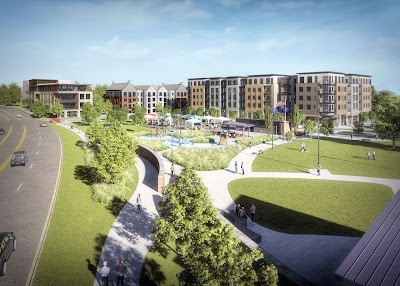 |
| Sidewalk bricks in Lancaster, PA |
Really?
Last winter I visited Brevard, North Carolina, a quaint little town of 7,600–a fraction of Noblesville’s population. Brevard is a progressive place. Stellar restaurants and coffee shops, breweries and boutiques line their historic downtown, as do brick sidewalks. These aren’t old neglected sidewalks, they’re well maintained and some are clearly newer.
We also spent some time in nearby Asheville, famous for its surrounding mountain forests, The Biltmore Estate, and its historic city center. Its population is a little larger than Noblesville’s. Ashville’s historic residential neighborhoods have lots of brick sidewalks made with shiny, salt glazed surfaces not unlike the Nelsonville Star Bricks familiar in Noblesville’s Old Town. There’s no evidence they’re taking them up, instead, they appear to be protecting and preserving them. In other parts of Ashville’s historic commercial areas they’re not only preserving brick sidewalks, but adding new ones.
 |
| Salt-glazed sidewalk bricks in Asheville, North Carolina |
Are North Carolinians uncaring of handicap folks? Are they so rich they laugh at the thought of ADA lawsuits?
In July we went to Lancaster, Pennsylvania for an annual business event. It’s another historic town with a population 10,000 fewer than Noblesville. And guess what? They’re not only preserving their historic sidewalk bricks, like Ashville they’ve installed new ones.
 |
| Savanna, Georgia sidewalk bricks |
You know what I didn’t see in any of these towns? Not one single concrete sidewalk with faux stamped brick surfaces. They’re installing and preserving the real thing.
What do they know that Noblesville doesn’t know? Did their city engineers fail the college course on ADA mandates?
Not likely. Asheville and Savannah clearly rely more on tourism than Noblesville to bouy their local economy, but that’s not true of Lancaster or Brevard. My guess is all four have a vision for their historic downtowns and they’ve committed to it. They’d jump at the stockpile of Star Bricks sitting at Noblesville’s Street Department and put them back in public spaces or sidewalks.
Noblesville could make the same commitment. It just requires the will to do it.
Are concrete sidewalks really safer? In general, I think yes. But when newly laid, I think brick sidewalks are nearly as safe. The problems come from repeated freeze and thaw cycles that heave the ground (all the towns I mentioned except Savannah experience routine freeze and thaw cycles) and the heaving caused by growing tree roots. But as I walk Noblesville’s sidewalks (which I do a lot) I don’t see an obvious advantage for concrete over brick.
 |
| New brick sidewalk being laid in Savannah |
Roundabout safety also challenges common logic . We assume they’re more dangerous than intersections with traffic lights, but that’s not true. Research shows that because of the rapid, yield-only movement in roundabouts, we enter them with greater vigilance. But at lighted intersections, it’s red or green, stop of go, and we trust it’s that simple. So when someone blows through a red light we’re more likely to get T-boned (which happened to me at 9th and Conner a few years back), or a pedestrian killed because we mistakenly trust all people will stop for all red lights. Research shows stoplight intersections are more dangerous than roundabouts because vigilance trumps trust.
I think sidewalks work much the same way. We subconciously trust that concrete sidewalks are one, smooth, flat surface. But they’re not. We expect brick sidewalks to be uneven, and so we subconsciously increase vigilance.
This heaved concrete sidewalk on N. 10th St. in Noblesville, making a 1.5" trip hazard, is not unusual, in fact, these are common. Yet, there's a very long stretch of smooth surface leading up to it, just enough to fool you into thinking there's nothing to trip over.
























